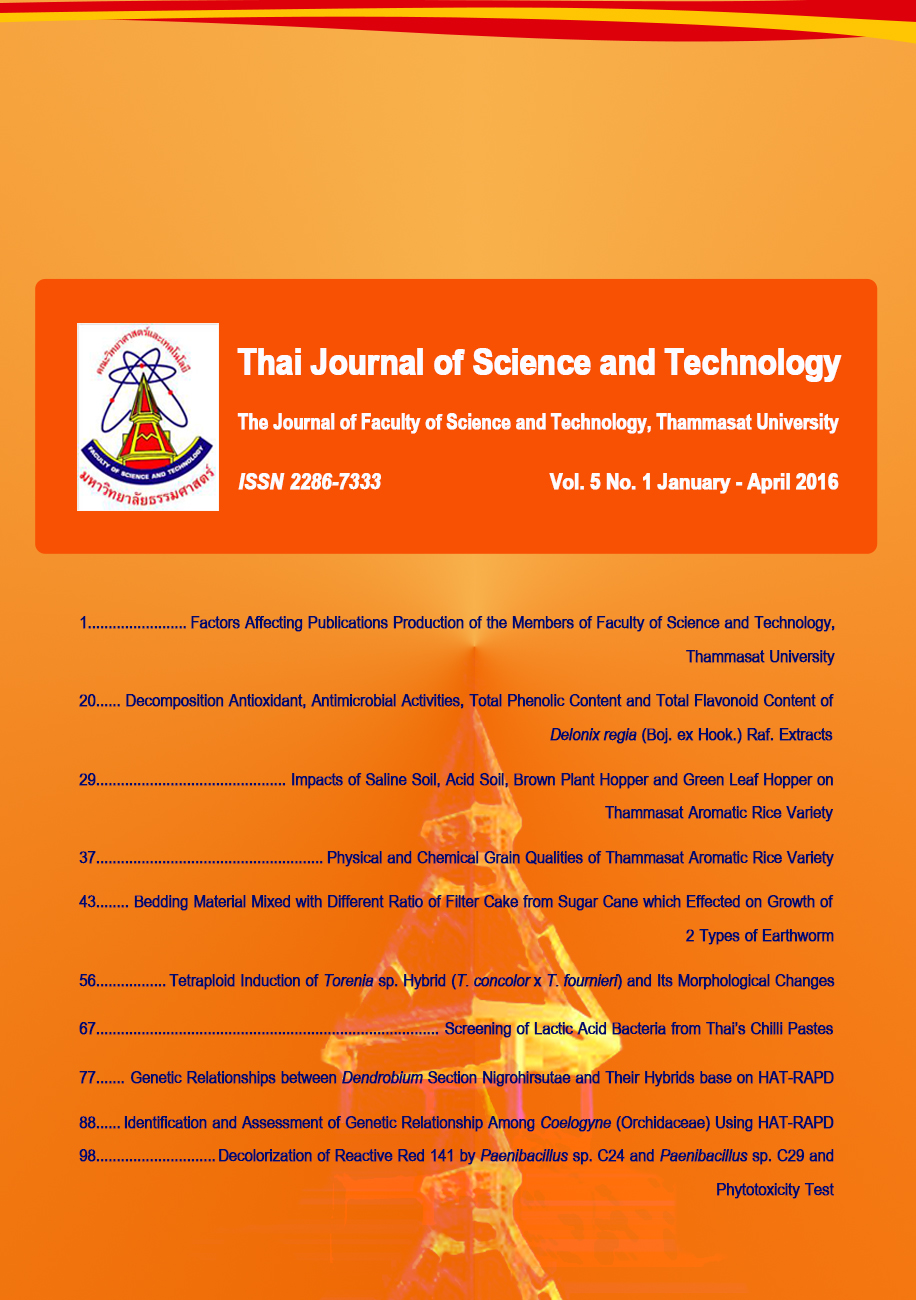การบำบัดสี Reactive Red 141 โดยแบคทีเรีย Paenibacillus sp. C24 และ Paenibacillus sp. C29 และการทดสอบความเป็นพิษของผลิตภัณฑ์หลังบำบัดกับพืช
Main Article Content
Abstract
บทคัดย่อ
การบำบัดสี Reactive Red 141 (RR141) โดยแบคทีเรีย Paenibacillus sp. C24 และ Paenibacillus sp. C29 ที่แยกได้จากดินประเทศญี่ปุ่น พบว่าแบคทีเรียทั้ง 2 สายพันธุ์ มีประสิทธิภาพในการบำบัดสี Reactive Red 141 ในสภาวะนิ่ง (static condition) ได้ 97.86±0.62 และ 96.97±0.98 เปอร์เซ็นต์ ตามลำดับ เมื่อใช้สภาวะการบำบัดที่เหมาะสม ดังนี้ ระยะเวลาการบำบัด 16 ชั่วโมง ค่าความเป็นกรดด่าง คือ 6.0 และ 7.0 อุณหภูมิที่ 35.0 และ 45.0 องศาเซลเซียส แหล่งไนโตรเจน คือ แอมโมเนียมคลอไรด์และยูเรีย และใช้กลูโคสเป็นแหล่งคาร์บอนที่เหมาะสมต่อการบำบัดสีของแบคทีเรียทั้ง 2 สายพันธุ์ โดยผลิตภัณฑ์หลังการบำบัดโดยแบคทีเรียทั้ง 2 สายพันธุ์ พบว่ามีค่าการดูดกลืนแสงสูงสุดเปลี่ยนแปลงไปจาก 546 เป็น 520 และ 517 นาโนเมตร ส่วนค่า COD removal (%) เท่ากับ 51.57 และ 63.36 เปอร์เซ็นต์ ตามลำดับ นอกจากนี้การวิเคราะห์หมู่ฟังก์ชันหลังจากการบำบัดสีโดยเครื่อง Fourier transform infrared spectrometer (FTIR) พบตำแหน่งของหมู่ NH2 ในกลุ่มเอมีน หมู่ SO2 ในกลุ่มซัลเฟอร์ และหมู่ CH ในกลุ่มอะโรมาติก แสดงให้เห็นว่าแบคทีเรียทั้ง 2 สายพันธุ์ สามารถย่อยสีได้ผลิตภัณฑ์สุดท้ายมีโครงสร้างที่เล็กลง เมื่อนำผลิตภัณฑ์หลังการบำบัดมาทดสอบความเป็นพิษกับข้าวพันธุ์ปทุมธานี 1 และถั่วเขียวพันธุ์กำแพงแสน 2 พบว่ามีผลต่อการเจริญเติบโตอย่างมีนัยสำคัญทางสถิติ
คำสำคัญ : แบคทีเรียบำบัดสี; สีแบบรีแอคทีฟ; ความเป็นพิษต่อพืช
Abstract
Efficiency of Reactive Red 141 (RR141) treatment by Paenibacillus sp. C24 and Paenibacillus sp. C29 isolated from soil in Japan was 97.86±0.62 and 96.97±0.98 at static condition. The optimal conditions for dye treatment were 16 hours, pH 6.0 and 7.0 at 35.0 and 45.0 °C, with ammonium chloride and urea as nitrogen sources and glucose as a carbon source for both bacteria. The maximum absorption wavelengths of the final products by bacterial treatments were changed from 546 to 520 and 517 nm. The percentages of COD removal were 51.57 and 63.69 %, respectively. Moreover, the functional groups after dye decolorizaion were determined by Fourier transform infrared spectrometer (FTIR). The NH2 peak of amine group, SO2 peak of sulfur group and CH peak of aromatic group were found. The results showed that both of bacterial strains could degrad RR141 to smaller structure of final products. The phytotoxicity of the final product was studied with rice (Pathum Thani 1) and mung bean (Kampangsan 2). The growth of these plants was significantly affected.
Article Details
บทความที่ได้รับการตีพิมพ์เป็นลิขสิทธิ์ของคณะวิทยาศาสตร์และเทคโนโลยี มหาวิทยาลัยธรรมศาสตร์ ข้อความที่ปรากฏในแต่ละเรื่องของวารสารเล่มนี้เป็นเพียงความเห็นส่วนตัวของผู้เขียน ไม่มีความเกี่ยวข้องกับคณะวิทยาศาสตร์และเทคโนโลยี หรือคณาจารย์ท่านอื่นในมหาวิทยาลัยธรรมศาสตร์ ผู้เขียนต้องยืนยันว่าความรับผิดชอบต่อทุกข้อความที่นำเสนอไว้ในบทความของตน หากมีข้อผิดพลาดหรือความไม่ถูกต้องใด ๆ


